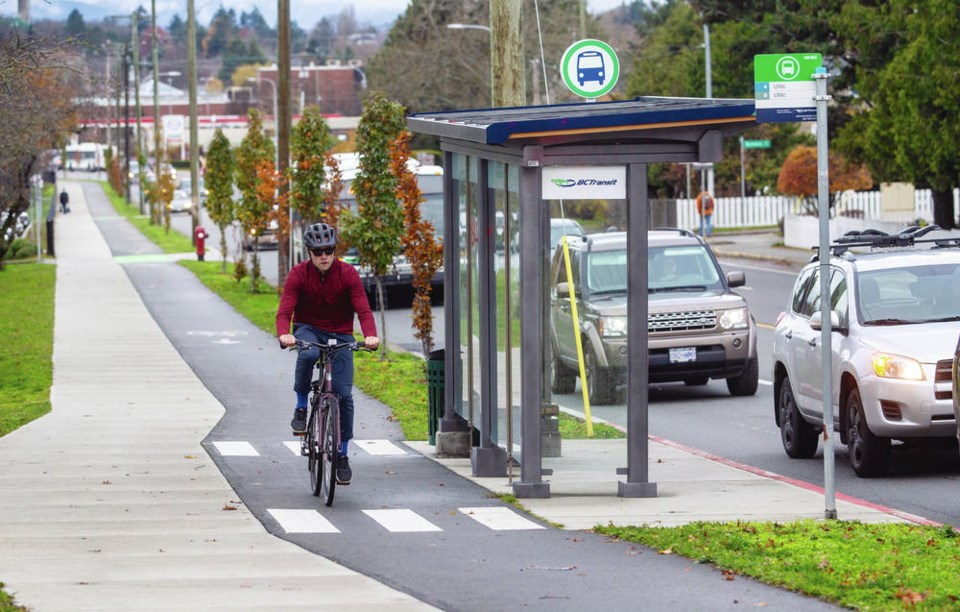The province will need to revise its design guidelines for protected bike lanes after a human rights ruling last week that the City of Victoria’s “floating” bus stops discriminate against blind people, says a Victoria cycling advocate.
In a decision released Nov. 13, B.C. Human Rights Tribunal member Norman Trerise said requiring pedestrians to cross bike lanes on Pandora Avenue and on Wharf Street to reach a bus stop discriminates against those who are blind or visually impaired, because they can’t know when it’s safe to cross.
Several witnesses for the complainant testified they rely on their hearing to determine when they can cross, but noise on busy streets drowns out the sound of an approaching bike.
Trerise agreed with testimony from cycling and transportation experts that the city had followed international best practices for the bikeway design. The city consulted several design guidelines to create the protected bike lanes, including B.C.’s Active Transportation Design Guide, which is used by municipalities across the province.
Corey Burger, policy and infrastructure chair of the Greater Victoria Cycling Coalition, said the ruling affects communities across B.C., many of which are now discussing the decision and wondering what it means for planning cycling infrastructure.
It’s crucial that the province’s design guidelines are revised based on the tribunal decision to provide consistency across the province, he said. “So if an unsighted person goes to Vancouver or goes to Kelowna, etc., they’re going to have the same experience crossing that bike lane that they do here in Victoria,” he said. “Let’s make sure that’s built in across the province.”
The Ministry of Transportation and Infrastructure, which is responsible for the 2019 document, said in a statement the design guide was introduced to make it easier for B.C. communities to incorporate active transportation into their infrastructure planning.
A spokesperson for the ministry said they’re not able to answer questions about whether there will be a review and update of the design guidelines until a new cabinet is sworn in on Nov. 26, saying only that the province will continue to adopt best practices and work with stakeholders to revise the design guide so it works for all British Columbians.
Burger said he was glad that the human rights decision affirmed the importance of building safer cycling infrastructure, noting that bikes are a way for some with mobility challenges to move around the city.
“There needs to be this balance of, you know, different people moving around the city, and everyone has a different set of challenges,” he said.
Oriano Belusic, who initiated the human rights complaint on behalf of the Canadian Federation of the Blind, said his needs are still not being met by the tribunal decision. Trerise wrote in his decision that the city installing pedestrian-activated flashing lights that make an audible signal when activated is a reasonable accommodation.
“The accepted solution is in some ways worse than what we were complaining about in the first place,” Belusic said.
He said that the audible signal to pedestrians indicating that the light is flashing gives a false sense of security that it’s safe to cross.
“It doesn’t mean that at all, because the cyclists don’t actually behave any differently because of the audible beeper or the flashing light,” he said.
The District of Saanich also has three “floating” bus stops: one each on the north and south sides of Lansdowne Road near Camosun College and a third on McKenzie Avenue east of Cedar Hill Road.
Belusic said he wasn’t aware of the Saanich stops until recently, because they’re not part of his regular routine, but he plans to check them out.
Graeme McCreath, former treasurer of the Canadian Federation of the Blind, said he’s currently focused on having concerns addressed in Victoria, but he expects the federation will likely reach out to Saanich in the future.
“I’m just fed up chasing around after this stuff,” he said. “I just can’t believe that we’re dealing with this stuff in these modern times. We seem to be left behind. Nobody thinks about us. And that’s not right.”
A spokesperson for the District of Saanich said they plan to review the tribunal decision to determine if any changes are needed.
A second hearing will take place in the future to determine a remedy for the City of Victoria floating bus stops



